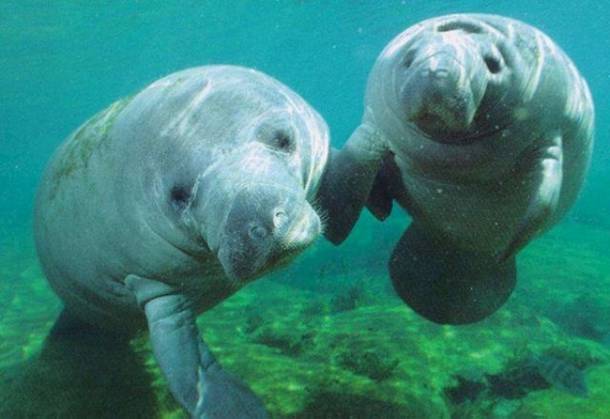Manatees are often referred to as sea cows. They are large slow moving mammals that are found in warm tropical waters through out the world. Manatee food is general plant matter but they sometime are seen eating fish and clams.
Species of Manatees
There are two different species of manatees. The West Indian Manatee which was once abundant is now listed as an endangered species. This species of manatee is primarily found around the Florida peninsula but has been spotted as far up as Rhode Island. There are also small groups that live out around , Mexico, northeastern South America and the Caribbean. They are also seen as far south as Brazil, Central and South America.
The West African manatees has a range reaching from Senegal to Angola, Africa. The Amazonian manatees live in fresh water. They inhabit areas around the Amazon Basin, in Brazil. There number have been drastically reduced to a very few living through out Peru, Ecuador, and Colombia.
What Manatees Eat
Manatees are herbivores. The main manatee food is plant matter that is along the shoreline, submerged, floating and emergent. In Florida manatee food consists of over 60 different types of plants. A few of the plants that they enjoy include:
-manatee grass
-turtle grass
-shoal grass
-various algae
-mangrove leaves
-hydrilla
-acorns
-water hyacinth.
Body Structure of the Manatee
Manatees are large animals weighing in at approximately 800 to 1200 pounds. They general grow to be 10 to 13 feet long. The females are normally larger than the males There was a female manatee found that weighed in at an amazing 3,650 pounds. A manatee has a streamlined body that is full around the middle then narrows and ends in a paddle-shaped tail. They are a grey color but can look more brown or green due to algae that grows on their body. They have two small pectoral flippers which they use for steering, eating and embracing other manatees.
Behavior of Manatees
Manatees are non aggressive and non territorial. They tend to socialize loosely in groups but spend most of their time alone eating and sleeping.
Gestation and Reproduction
A female manatee only produces one calf every two to five years. Twins do happen occasionally but this is rare. This is one of the reasons their numbers are now so low. Their slow reproduction rate cannot keep up with the number of manatees that are being killed regularly. The gestation time is 12 months. The calf is normally weaned with in a year but stays with the mother for two years to learn about feeding and traveling.
Life Expectancy and Cause of Death
Manatees can naturally live to be 50 to 60 years old. The unfortunate truth is more manatees die because of human causes than they do of natural causes. The mortality rate for manatees has risen about 5.3% a year since 1976. Boats are a major risk to manatees. Many manatees are seen with wounds and scars across their back which are caused from boat propellers. Manatees are not fast enough to get out of the way of the oncoming boats. Because of their dark color it is hard for boaters to see them in the water.
Manatees are gentle animals that are being killed off faster than they can repopulate their numbers. It is important that they are safe guarded and protected before it is too late.
Terry Loater is a freelance writer and journalist, covering issues surrounding wildlife and nature. He is interested in animals and writes about them for magazines and websites (see this link).

